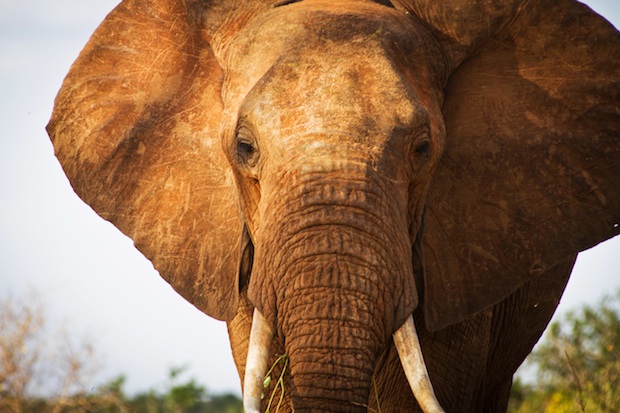Laikipia
The bull elephant had roamed our northern marches of the Laikipia plateau for decades. I always recognised him when he passed through the farm because his handsome 65-pound tusks had a distinctive curve and a thickness that showed his ivory might have grown much larger, had he lived. Instead, armed Pokot poachers ambushed him as he browsed with two other younger bulls one afternoon in the woodland at the top of our Pinguaan valley. They sprayed a burst of bullets at him and several rounds ripped into his lungs and guts. He was mortally wounded, but staggered away bleeding. The poachers chased him up and their aim would be to finish the job of killing, then use an axe to hack away half his skull to extract the tusks, which they would take off to sell to a Somali, who would sell to a Chinese man, who would smuggle the tusks to China. The poachers’ plan was spoiled when a courageous man who had heard the shooting arrived on the remote scene and engaged them in a brief exchange of gunfire. They ran away without their trophies. By this time the bull elephant was long gone. He bled profusely from the high-velocity bullet wounds that had torn his internal organs, but he died slowly, stumbling through bush, among rocks of our valley, sagging on his great legs as he struck out on to the high plains, separated from his younger askari bulls and the sight of the main herd of females, blinded by pain and falling and rising once more and then collapsing for the last time. We could see the course of his last tragic journey in his tracks up to the point where his carcass lay. Within hours of his death the predators had converged and when we arrived the great cage of his chest was a door, out of which a lioness emerged caped with gore. Her young cubs were around her already stuffed with meat. When the lions were done hyenas, silver-backed jackals and vultures closed in, taking their turns to consume what they could of this great mountain of flesh. It was the only wonderful aspect of this terrible sight, to see the multitude of animals all feeding for a day. But the bull was simply too large to devour entirely. By the next day his corpse had bloated into a thing like a crashed zeppelin, with legs stuck out straight, his thick hide splashed white with droppings that ran down the cork-tree wrinkles of his flanks. Scavengers had gashed into his guts through the backside until they could eat no more, nor bear the stink of putrefaction that hung around this rotting balloon stuck in a puddle of faeces and chyme. It was over. As we drove away among the vultures, they were so replete they flapped off on their legs like drunks but could not get airborne. The corpse was headless. Soon after the bull died, to prevent the poachers from coming at the dead of night to retrieve those tusks, the brave neighbour had hacked the skull off with a chainsaw, hooked it up with chains to the back of his tractor and towed the great thing back to his farmyard until the wildlife services arrived. The action of dragging the head along the rough ground had rubbed all the skin off but not the flesh. The head sat in the farmyard with the eyes still in their sockets, perfectly intact, and as I stood there the bull seemed alive as he looked at me, unblinking. I thought: ‘Was that eye fixed on his killers? Does he accuse me?’ We will lose all our elephants if this goes on. Poor men pull the trigger to feed their families. Our African governments are ineffectual or corrupt or both, allowing traders to operate almost with impunity. And the buyers are Chinese, millions of them, who believe ivory will bring them luck, and that removing tusks will not kill an elephant any more than sheering a fleece will cause the death of a sheep. Whatever we have been doing up to this point has failed. Celebrity conservationists in their donated safari vehicles have failed. Journalists like me have failed. I personally favour sport hunting as a way to conserve wildlife. I think poor people have to see a value in an animal, and they might set out to protect game if a monetary value is put on the head of an elephant, or a lion, or a rhino. I personally dislike the idea of killing an elephant or lion or rhino, but I am just interested in what works in conservation. In Kenya especially there are many people who will disagree with me, and overseas there are animal-rights activists who will foam at the mouth. It doesn’t matter. We have all failed and we need a fresh plan. Aidan Hartley
Aidan Hartley
Killing in Kenya: Aidan Hartley tracks the last steps of an elephant

issue 24 August 2013





Comments